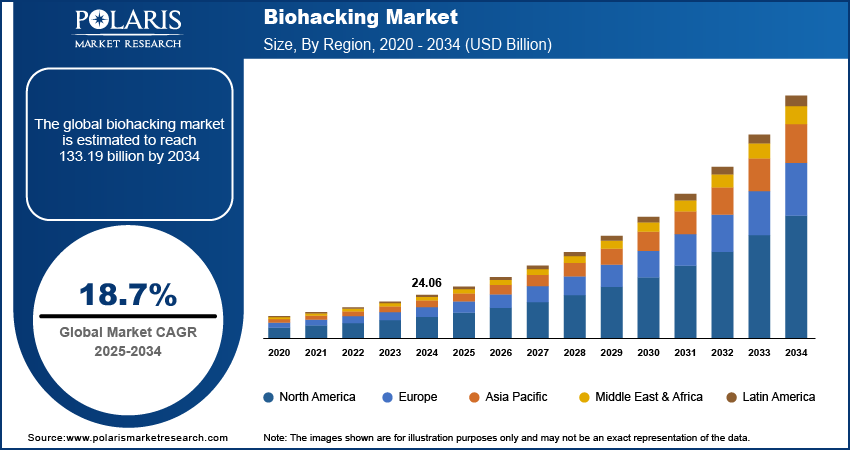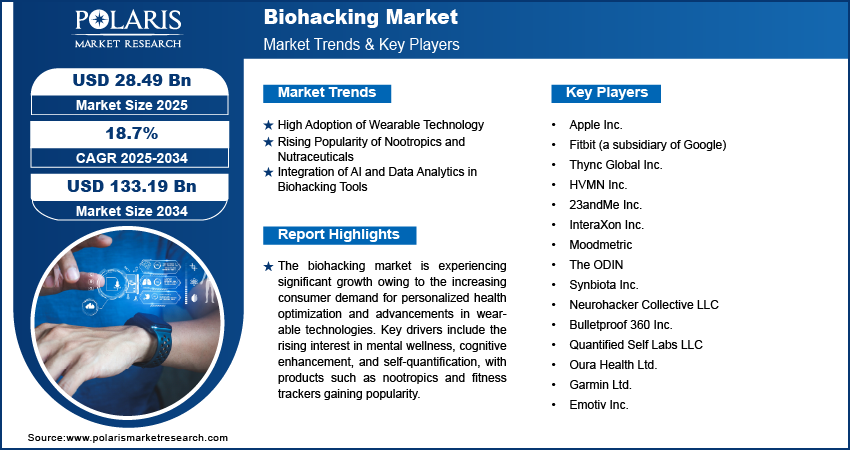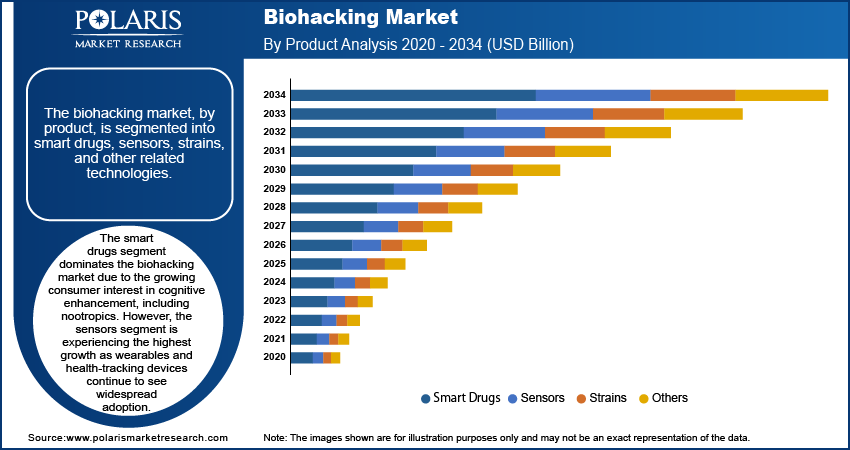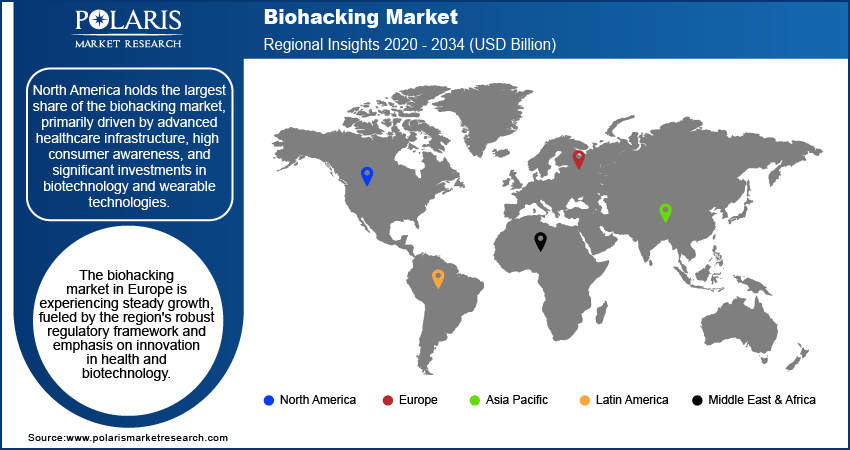
Biohacking Market Size, Share, Trends, Industry Analysis Report
: By Product (Smart Drugs, Sensors, Strains, and Others), Application, End Users, and Region (North America, Europe, Asia Pacific, Latin America, and Middle East & Africa) – Market Forecast, 2025–2034
- Published Date:Jan-2025
- Pages: 119
- Format: PDF
- Report ID: PM1732
- Base Year: 2024
- Historical Data: 2020-2023
Biohacking Market Overview
The biohacking market size was valued at USD 24.06 billion in 2024. The market is projected to grow from USD 28.49 billion in 2025 to USD 133.19 billion by 2034, exhibiting a CAGR of 18.7% during 2025–2034.
The biohacking market refers to the industry centered on products, services, and practices aimed at enhancing human performance, health, and longevity through self-experimentation, biotechnology, and advanced wellness solutions. Key factors such as the growing consumer interest in personalized healthcare, advancements in wearable technology, and increased awareness of preventative health measures drive the biohacking market demand. Notable trends include the integration of artificial intelligence (AI) and machine learning in biohacking tools, the expansion of nootropics and nutraceuticals, and the rise of DIY biology practices. The market is supported by a demand for data-driven solutions to optimize physical and cognitive well-being.

To Understand More About this Research: Request a Free Sample Report
Biohacking Market Dynamics
High Adoption of Wearable Technology
The biohacking market is witnessing significant integration of wearable devices designed to monitor and optimize physical and cognitive health. Devices such as fitness trackers, smartwatches, and continuous glucose monitors have become popular among consumers aiming for real-time health insights
Rising Popularity of Nootropics and Nutraceuticals
Nootropics and nutraceuticals are emerging as key trends within the biohacking market due to increasing consumer interest in cognitive enhancement and preventative health. Nootropics, often referred to as “smart drugs,” focus on improving memory, focus, and mental performance, while nutraceuticals emphasize the use of natural ingredients for health benefits. According to a 2023 report by the Council for Responsible Nutrition, 77% of American adults consume dietary supplements, with brain health being a top priority for nearly 30% of users. The increasing availability of science-backed formulations is further driving this trend.
Integration of AI and Data Analytics in Biohacking Tools
The adoption of artificial intelligence (AI) and data analytics is transforming the biohacking landscape, enabling personalized health solutions and advanced predictive models. AI-powered tools analyze vast datasets from wearable devices and other biohacking applications to provide actionable insights tailored to individual needs. AI has the potential to enhance patient outcomes significantly, which aligns with its growing role in biohacking. This trend reflects the demand for data-driven approaches to optimizing health and performance, offering users precise, evidence-based strategies for improvement. Thus, the growing integration of AI and data analytics in biohacking tools propels the biohacking market development.

Biohacking Market Segment Insights
Biohacking Market Outlook – Product-Based Insights
The biohacking market, by product, is segmented into smart drugs, sensors, strains, and other related technologies. The smart drugs segment holds the largest market share, driven by the rising consumer demand for cognitive enhancement and mental health support. The increasing prevalence of stress-related disorders and the growing awareness of brain health have propelled the adoption of nootropics. Additionally, advancements in pharmaceutical research and the availability of over-the-counter cognitive enhancers have contributed to the segment's prominence. Products in this category are gaining traction among professionals, students, and individuals seeking improved focus and productivity, further solidifying their market leadership.
The sensors segment is registering the highest growth, fueled by technological advancements and the increasing use of wearable and implantable devices. These products enable users to monitor health metrics such as heart rate, glucose levels, and sleep patterns in real-time, aligning with the trend of personalized healthcare. Innovations in biosensors and the integration of AI to analyze health data are driving demand in this segment. The growing focus on preventative care and self-monitoring among tech-savvy consumers supports the rapid adoption of sensors, positioning them as a critical component of the biohacking market's future.
Biohacking Market Assessment – Application-Based Insights
The biohacking market, by application, is segmented into synthetic biology, genetic engineering, forensic science, diagnosis & treatment, and drug testing. The diagnosis and treatment segment holds the largest market share, driven by advancements in personalized medicine and the increasing adoption of biohacking tools to monitor and manage chronic diseases. With the rise in wearable health technologies and bioinformatics platforms, consumers and healthcare providers are leveraging biohacking solutions for early detection, improved therapeutic outcomes, and precision medicine. This segment benefits from a growing focus on preventive healthcare and the integration of real-time health monitoring systems.
The synthetic biology segment is experiencing the highest growth rate due to innovations in biotechnology and its expanding applications in biohacking. Developments in CRISPR and CAS gene technology, DNA synthesis, and metabolic engineering are enabling breakthroughs in creating customized biological systems for health and performance enhancement. The segment's growth is supported by rising investments in research and development, along with increasing interest from biohacking enthusiasts in DIY biology practices. The scalability and accessibility of synthetic biology tools are further propelling their adoption across various consumers and industrial applications.
Biohacking Market Evaluation – End Users-Based Insights
The biohacking market, by end users, is segmented into pharmaceutical & biotechnology companies, forensic laboratories, and others. The pharmaceutical and biotechnology companies segment dominates the market share, driven by their extensive use of biohacking techniques in drug discovery, development, and production processes. These companies leverage biohacking tools such as genetic engineering and synthetic biology to accelerate innovation and improve the efficacy of therapeutics. The segment's leadership is further reinforced by ongoing research collaborations and the integration of advanced bioinformatics, enabling more precise and efficient outcomes in clinical trials and product pipelines.

The forensic laboratories segment is experiencing the highest growth rate within this market, propelled by advancements in genetic analysis and bioinformatics tools used in criminal investigations. The increasing application of biohacking solutions for DNA profiling, toxicology testing, and evidence analysis has significantly enhanced the accuracy and reliability of forensic processes. Rising investments in forensic technologies and the adoption of AI-driven biohacking platforms are further augmenting the growth of this segment, addressing the growing demand for sophisticated methodologies in law enforcement and criminal justice systems.
Biohacking Market Regional Insights
By region, the study provides biohacking market insights into North America, Europe, Asia Pacific, Latin America, and the Middle East & Africa. North America holds the largest share of the biohacking market revenue, primarily driven by advanced healthcare infrastructure, high consumer awareness, and significant investments in biotechnology and wearable technologies. The region’s leadership is further supported by a strong presence of key market players and a well-established ecosystem for research and development in personalized medicine and genetic engineering. The rising adoption of wearable devices and the increasing prevalence of chronic diseases in the US also contribute to the region’s dominance in the global market.
The biohacking market in Europe is experiencing steady growth, fueled by the region's robust regulatory framework and emphasis on innovation in health and biotechnology. Countries such as Germany, the UK, and France are leading in the adoption of biohacking practices, supported by government-backed initiatives and funding for research in synthetic biology and genetic engineering. Additionally, the growing focus on preventative healthcare and the integration of advanced diagnostic tools are key factors driving biohacking market expansion in the region.
Asia Pacific is emerging as a high-growth region in the global biohacking market, driven by rising consumer interest in health and wellness and the growing accessibility of advanced technologies. The region’s expanding healthcare sector, particularly in countries such as China, Japan, and India, supports the adoption of biohacking tools and practices. Increased investments in biotechnology research and the proliferation of wearable devices tailored to local consumer needs are contributing to the rapid growth of the market in this region.

Biohacking Market – Key Players and Competitive Insights
The biohacking market includes several key players actively contributing to advancements in health optimization, wearable technologies, and biotechnology. A few prominent companies in this market are Apple Inc., Fitbit (now part of Google), Thync Global Inc., HVMN Inc., 23andMe Inc., InteraXon Inc., Moodmetric, The ODIN, Synbiota Inc., Neurohacker Collective LLC, Bulletproof 360 Inc., Quantified Self Labs LLC, Oura Health Ltd., Garmin Ltd., and Emotiv Inc. These companies specialize in various aspects of biohacking, including genetic testing, wearable health monitors, cognitive enhancement tools, and synthetic biology kits.
Apple Inc. and Fitbit have a strong presence in the wearable technology segment, offering health-tracking devices that appeal to a broad consumer base. HVMN Inc. and Neurohacker Collective focus on cognitive enhancement and nutraceuticals, catering to the demand for brain health products. Companies such as 23andMe and The ODIN lead in genetic testing and DIY biology tools, attracting consumers interested in personalized health and experimentation. Meanwhile, Oura Health and Garmin provide advanced wearable solutions for sleep and activity monitoring, emphasizing precision and usability in their products. This diversity in offerings highlights the segmented nature of the biohacking market, with each player focusing on niche applications.
Insights into this competitive landscape reveal that companies are leveraging technological advancements and consumer interest in self-quantification to expand their reach. Collaborations with research institutions and increased investments in AI and biotechnology are common strategies to maintain relevance and drive innovation. Additionally, the market is seeing a shift toward more accessible and user-friendly solutions, enabling consumers with varying levels of expertise to adopt biohacking practices effectively. This balance of innovation and usability is shaping the competitive dynamics of the market.
Apple Inc. is a significant player in the biohacking and health technology market, primarily through its wearable devices such as the Apple Watch and AirPods. The Apple Watch has evolved into a robust health-monitoring tool, offering features such as ECG capabilities, irregular heart rhythm notifications, and AFib monitoring. Apple continues to explore innovative technologies such as noninvasive blood glucose monitoring using laser-based systems, although these features are still under development.
Thync is an active player focusing on neurostimulation devices. Its products, such as wearable systems designed to influence stress levels and enhance sleep, have gained attention for their scientific approach to biohacking. The company aims to provide users with noninvasive methods to optimize their mental health. A significant highlight in recent years is its collaboration with research institutions to refine its neurostimulation technology, which has expanded its application scope into wellness and clinical settings.
List of Key Companies in Biohacking Market
- Apple Inc.
- Fitbit (a subsidiary of Google)
- Thync Global Inc.
- HVMN Inc.
- 23andMe Inc.
- InteraXon Inc.
- Moodmetric
- The ODIN
- Synbiota Inc.
- Neurohacker Collective LLC
- Bulletproof 360 Inc.
- Quantified Self Labs LLC
- Oura Health Ltd.
- Garmin Ltd.
- Emotiv Inc.
Biohacking Industry Developments
- In November 2024, Apple announced its plans to expand the AirPods' functionality to include hearing tests and over-the-counter hearing aids, showcasing its commitment to integrating health solutions into its consumer products.
- In July 2024, Vieroots announced to launch India's first Biohack Centre at Kochi.
Biohacking Market Segmentation
By Product Outlook
- Smart Drugs
- Sensors
- Strains
- Others
By Application Outlook
- Synthetic Biology
- Genetic Engineering
- Forensic Science
- Diagnosis & Treatment
- Drug Testing
By End Users Outlook
- Pharmaceutical & Biotechnology Companies
- Forensic Laboratories
- Others
By Regional Outlook
- North America
- US
- Canada
- Europe
- Germany
- France
- UK
- Italy
- Spain
- Netherlands
- Russia
- Rest of Europe
- Asia Pacific
- China
- Japan
- India
- Malaysia
- South Korea
- Indonesia
- Australia
- Vietnam
- Rest of Asia Pacific
- Middle East & Africa
- Saudi Arabia
- UAE
- Israel
- South Africa
- Rest of Middle East & Africa
- Latin America
- Mexico
- Brazil
- Argentina
- Rest of Latin America
Biohacking Market Report Scope
|
Report Attributes |
Details |
|
Market Size Value in 2024 |
USD 24.06 billion |
|
Market Size Value in 2025 |
USD 28.49 billion |
|
Revenue Forecast by 2034 |
USD 133.19 billion |
|
CAGR |
18.7% from 2025 to 2034 |
|
Base Year |
2024 |
|
Historical Data |
2020–2023 |
|
Forecast Period |
2025–2034 |
|
Quantitative Units |
Revenue in USD billion and CAGR from 2025 to 2034 |
|
Report Coverage |
Revenue Forecast, Market Competitive Landscape, Growth Factors, and Trends |
|
Segments Covered |
|
|
Regional Scope |
|
|
Competitive Landscape |
|
|
Report Format |
|
|
Customization |
Report customization as per your requirements with respect to countries, regions, and segmentation. |
How is the report valuable for an organization?
Workflow/Innovation Strategy
The biohacking market has been broadly segmented on the basis of product, application, and end users. Moreover, the study provides the reader with a detailed understanding of the different segments at the global and regional levels.
Growth/Marketing Strategy
The biohacking market growth strategies focus on innovation and consumer accessibility. Companies emphasize integrating advanced technologies, such as AI, wearable devices, and synthetic biology, to meet evolving consumer needs. Marketing efforts include partnerships with healthcare providers and research institutions to establish credibility and expand application areas. Additionally, brands are leveraging direct-to-consumer approaches, social media, and influencer marketing to educate and engage health-conscious users. The increasing focus on personalization in healthcare and wellness is further driving adoption and creating new opportunities for market expansion.
FAQ's
The biohacking market size was valued at USD 24.06 billion in 2024 and is projected to grow to USD 133.19 billion by 2034.
The market is projected to register a CAGR of 18.7% during the forecast period.
North America had the largest share of the market in 2024.
A few prominent companies in this market are Apple Inc., Fitbit (now part of Google), Thync Global Inc., HVMN Inc., 23andMe Inc., InteraXon Inc., Moodmetric, The ODIN, Synbiota Inc., Neurohacker Collective LLC, Bulletproof 360 Inc., Quantified Self Labs LLC, Oura Health Ltd., Garmin Ltd., and Emotiv Inc.
The smart drugs segment accounted for the largest share of the market in 2024.
The synthetic biology segment accounted for the largest share of the market in 2024.
Biohacking refers to the practice of making small, incremental changes to the human body and mind using science, technology, and self-experimentation to enhance physical and cognitive performance. This can include interventions such as genetic modification, dietary changes, and the use of wearable technology and supplements to optimize health. It also encompasses activities such as nootropics use (substances aimed at improving brain function), sleep optimization, and physical performance enhancement. Biohacking extends beyond traditional medicine, often involving DIY biology where individuals experiment on themselves to achieve personal health and wellness goals
A few key biohacking market trends are described below: Integration of Wearable Technology: Devices such as smartwatches and fitness trackers continue to be popular, providing users with real-time health data to monitor heart rate, sleep, activity levels, and more. This trend is being supported by advancements in sensor technology and AI for personalized insights. Rise of Nootropics and Cognitive Enhancement: The increasing interest in supplements, nootropic substances, and mental performance optimization is driving demand. Consumers are seeking products that claim to enhance memory, focus, and overall brain health. Growth in Personalized Health Solutions: The shift toward individualized care, powered by genetic testing, wearables, and health data analytics, is enabling consumers to make informed decisions about their health. This trend is propelled by consumer awareness and growing demand for precision medicine.
A new company entering the biohacking market must focus on areas such as personalized health solutions and mental wellness optimization. Offering unique, AI-driven wearable devices that provide real-time health insights or integrating cognitive enhancement tools such as nootropics could differentiate the brand. Additionally, exploring DIY biohacking kits for home-based genetic testing or health monitoring could appeal to the growing trend of self-experimentation. Focusing on user-friendly, accessible products and leveraging advanced data analytics to provide actionable health recommendations would further position the company as an innovative player in this expanding market.
Companies manufacturing, distributing, or purchasing biohacking and related products and other consulting firms must buy the report
